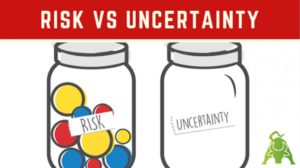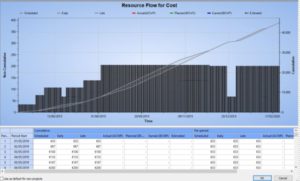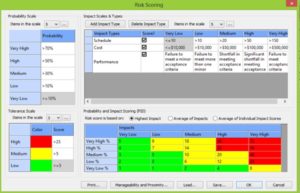Project Risk & Uncertainty Analysis
By default, a project must be finished by the deadlines written into the contract. Projects often fall behind schedule with cost and time impacts, and the company will face negotiations related to contractual milestone dates or the payment of late penalties for certain contractual milestones.
It is essential for the company to be able to establish secure bids from a project planning and cost perspective. Planning and scheduling tasks by phase or batch helps engineers and cost planners decide which options to take to meet deadlines and budgets.
Construction activities often create uncertainties that can lead to delays in the execution of certain tasks, which can increase the cost of the project. It is therefore essential to implement a risk management process related to project planning in order to meet contractual commitments as closely as possible.
Risk management is increasingly requested by project owners during the tendering phase, so that they can diagnose the quality of the responses provided by companies in terms of risks.
Why conduct a cost and schedule risk analysis?
The risk analysis assesses the likelihood that a project will be completed on time and on budget. The analysis can also assess the amount of budget contingencies, which can be useful. To calculate the amount of penalties, MESLI Consulting employs specific planning techniques in conjunction with Primavera Risk Analysis.
MESLI Consulting suggests the following steps to deploy during a risk analysis with Oracle Primavera Risk Analysis.
Our experts will use data based on their experience feedback to make a precise contribution during the schedule preparation with the verification of the schedule according to the DCMA criteria, including logic, margins, durations, resources, … . Thus, we will be able to have a relevant result for the risk analysis and the highlighted scenarios.
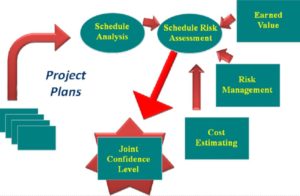
The steps are as follows:
1- Scheduling (check the schedule with the Schedule check option)
2-Resource Allocations in Primavera Risk Analysis and Budgeting (Resources)
3- Uncertainty analysis (durations) and Monte Carlo simulation
4- Risk register (assessment)
5- Simulation (Monte Carlo) in pre-mitigation phase
6- Simulation in the post mitigation phase
7- Risk analysis (reports, distribution analyzer, tornado graphs, scatter diagrams)
8- Response plan (risk control)
Practical differences between uncertainty and risk
- A) Uncertainty is inherent in a task
Example : A trench is scheduled to take 10 days to complete. It may take only 8 days, or it may take up to 12 days.
We will use the three-point distribution analysis to obtain a better estimate.
- B) Risks are events that may or may not occur that could affect a task
1- It can change the effect on the duration, cost, and quality of a task
Example : There is a 5% risk of flooding, which could delay the digging of the trench by 5 to 8 days.
2- It can change the sequence of activities
Example: There is a 15% chance that there will be power problems with a pump, or its replacement with a new specification could result in a change in the design of the power equipment.
Qualitative analysis
The qualitative analysis allows the risks to be prioritized according to their severity, so that they can be subjected to further quantitative analysis. The following table shows the result of the qualitative analysis.
After the parameterization and the calculation of the optimistic and pessimistic durations, the three durations are inserted in the software. Thus, a simulation is executed between 5 00 and 10 00 iterations. The following table shows the calculation of the durations by Monte-Carlo simulation.
Tornado – find the priority for the risks
1- About sensitivity
Sensitivity can be measured in terms of the cost and duration of each task. It gives an indication of the impact of the cost and time to complete the project as a whole.
It can be used to identify the tasks most likely to impact your project. The sensitivity values for each task can be displayed in a column of the Gantt chart or in the Tornado graph.
2- Default time sensitivity
Duration sensitivity is the relationship between how long a task takes and how long the whole project takes.
The task with the highest duration sensitivity is the one that is most likely to increase the project duration.
3- Default cost sensitivity
Cost sensitivity represents the correlation between the cost of a task and the cost of the project.

Scatter plot
The scatter plot shows the relationship between two results of a risk analysis. Each point in the scatter plot represents two values for one iteration of the risk analysis. The total number of points is equal to the number of iterations performed in the risk analysis.
Probabilistic cash flow
Critical forecasts, long-term budgeting, and EVMS reporting are communicated through the probabilistic cash flow.
In addition to the reporting options, the tool includes the ability to filter the probabilistic cash flow by specific resources/cost categories within the project plan.
Important elements and steps of the risk register
- Cost (impact on task, WBS or project budget)
- Planning (impact on task, WBS or project duration)
- Performance (acceptance criteria)
- Scope (change the scope of a task or project)
- Quality (leading to lower or higher quality)
- Risk quantification: Probability and impact
- Analyze the matrix
- Quantitative assignment
- Build an impact risk plan
The simplest and best known tool for risk analysis is the risk matrix or risk assessment matrix.
The score matrix must be set up beforehand. This one is schematized on the basis of the figure below:
The content of a risk register
– Owner – Who is responsible for the risk (optional)
– Cause – Details of the cause of the risk (optional)
– Description – A description of the risk (optional)
– Effect – Details of the effect of the risk (optional)
– RBS – A text field for entering the risk allocation structure/risk category (optional): Organizational, Environmental, Political, Economic, Operational, Technological
– Status – Whether the risk is proposed, open, rejected (closed), managed (closed), or impacted (closed), a closed risk is not used in the analysis. Open and proposed risks can be optionally included or excluded when developing the impacted risk plan
– Manageable – The extent to which the risk is manageable. Can be customized in the risk scoring and can be used to modify risk scores (optional)
– Proximity – The proximity of the risk. Can be customized in the risk rating (automatically calculated)
– Start Date – The expected date that the risk will begin
– End Date – The date on which the risk ends
– Exposure – Used to record the risk exposure on the project. See Risk Register
– In the Quantitative tab – Include the risk in the Quantitative tab. Risks that you do not intend to associate with project tasks can be left unchecked, shortening the list of risks in the Quantitative tab.
– Quantified – Check this option to allow you to customize the impact of the risk on individual tasks due to the qualitative defects.
The type of mitigation measures to be implemented after the risks are recorded :
– Avoid – Modify the project to avoid the risk. This usually reduces the post-mitigation probability to zero.
– Transfer – Transfer the risk to another party. (Insurance, lump sum, warranty for equipment)
– Reduce – Reduce the probability and/or impact of the risk.
– Accept – Accept the risk and take no mitigation action.
– Opportunities : (Time reduction, new technologies, solutions, resources…)
– Exploit – Actively seek the opportunity. Eliminate the uncertainty associated with a particular risk
– Improve – Increase the likelihood and/or impact of the opportunity (Resources).
– Reject – Reject the opportunity and take no action.
Actions should be taken, taking into account the different types of risks, if high: Response Plan; Emergency Plan, if medium: Response plan and if low: Accept.
Important points of the risk assessment
MESLI Consulting offers the following guidelines to consider when assigning and analyzing risks in a project :
The purpose of planning risk analysis – the three points
– What is the likelihood that the project will be delivered on time?
– What are the most important risks to mitigate?
– The probability distributions should be combined with the simulation
– The most likely completion date, the P-80 date
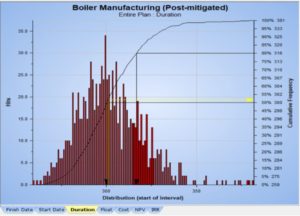
Gather quality data on project planning risks
- Collection of data related to the planning
- Interviews to obtain information
Criticality of risks
- What are the schedule risks?
- What activities could delay the project?
Constraints and their effects on risk analysis
- Why are constraints not recommended for simulation?
- Treatment of correlations in simulation
The risk factor method using the risk register
- New method to manage uncertainty on task durations
- Use the risk register directly
- Assign risks to tasks and simulate

Conclusion
MESLI Consulting has developed a methodology for risk analysis related to the planning of your projects. We propose customized risk studies in order to evaluate the completion time and secure the cost of your projects. The tool is perfectly adapted for large-scale projects with complexity, such as the Grand Paris Express or large industrial projects.
Risks are identified both by a documentary analysis and by interviews with the key people in the project. Any factor delaying an activity is considered a risk that should be studied carefully in order to anticipate the good progress of the project and the partial deadlines of the act of commitment signed between the stakeholders: Project owner, project manager, and contractor.
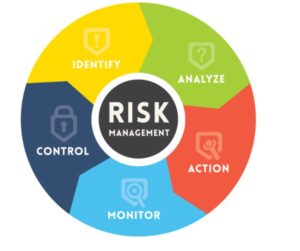
For any clarification or advice on project planning, do not hesitate to contact our services. We will take the time to talk with you about your projects and help you find ways to manage them.

